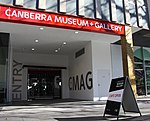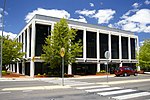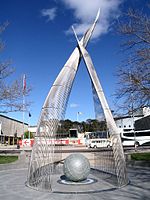Jolimont Centre
1983 establishments in AustraliaAccor hotelsBus stations in AustraliaBus transport in CanberraCommercial buildings completed in 1983 ... and 5 more
Commercial buildings in the Australian Capital TerritoryHotels in the Australian Capital TerritoryTransport buildings and structures in the Australian Capital TerritoryTransport infrastructure completed in 1983Use Australian English from March 2018

The Jolimont Centre is a commercial building in Canberra, Australia. It is also the city's long-distance coach station.
Excerpt from the Wikipedia article Jolimont Centre (License: CC BY-SA 3.0, Authors, Images).Jolimont Centre
Northbourne Avenue,
Geographical coordinates (GPS) Address Nearby Places Show on map
Geographical coordinates (GPS)
| Latitude | Longitude |
|---|---|
| N -35.277585 ° | E 149.12905 ° |
Address
Northbourne Avenue
2601 , City
Australia
Open on Google Maps









